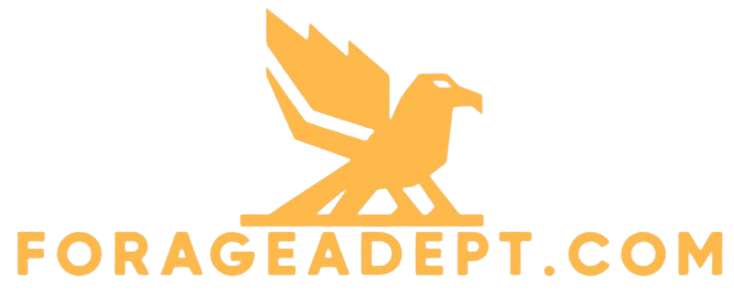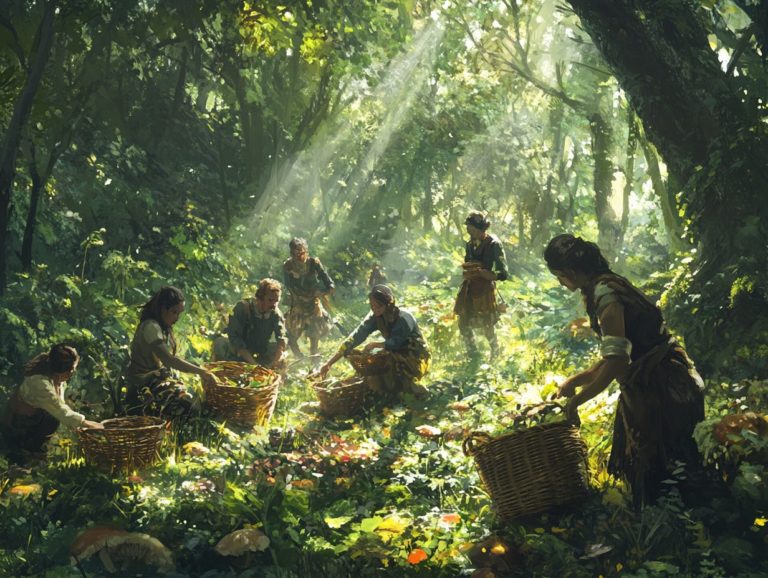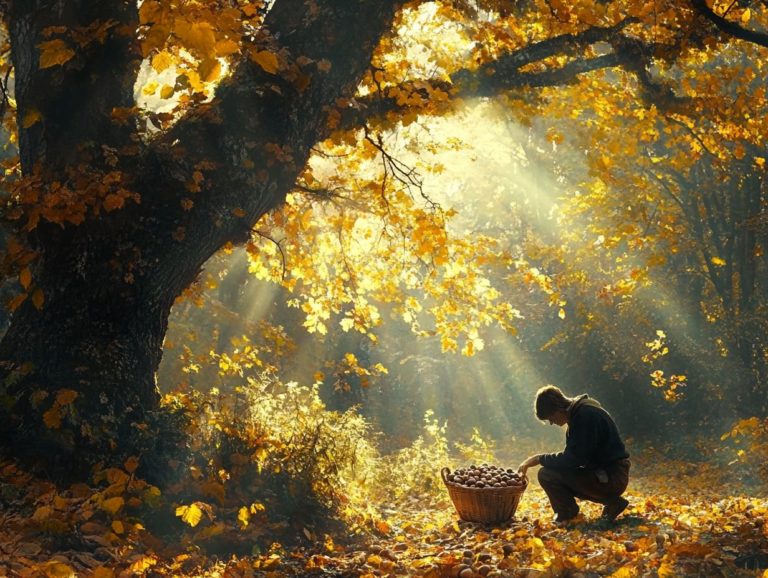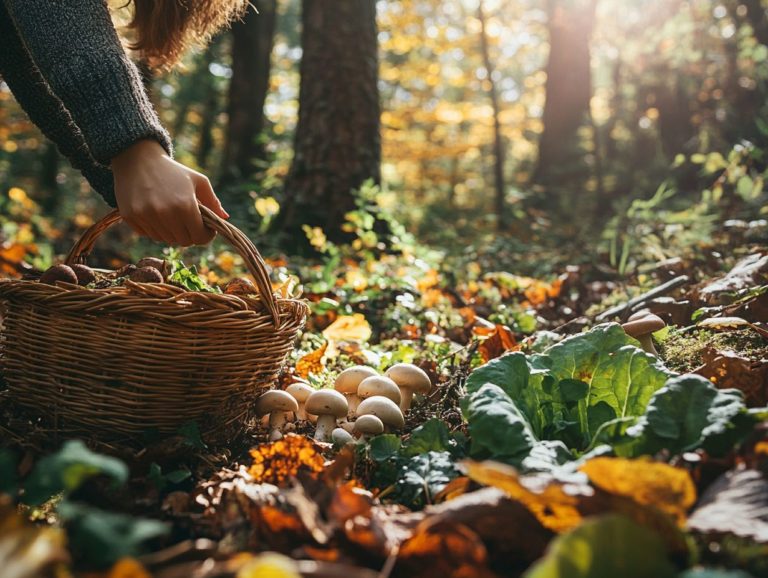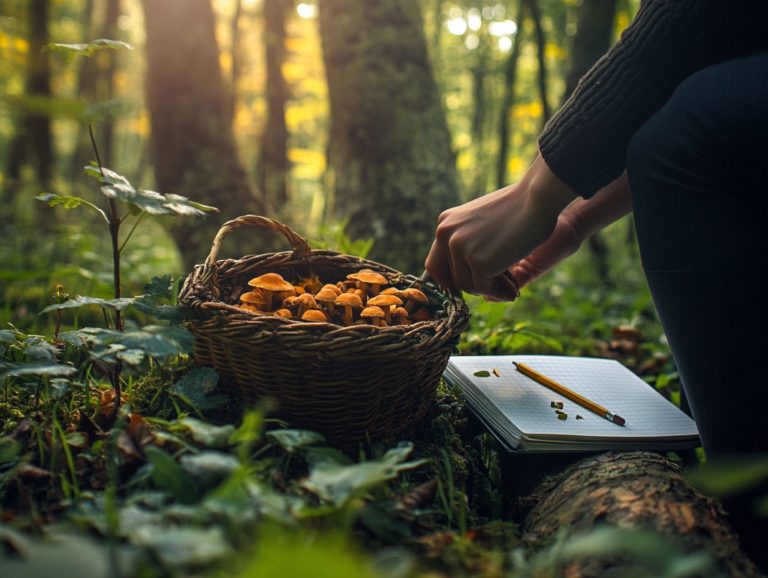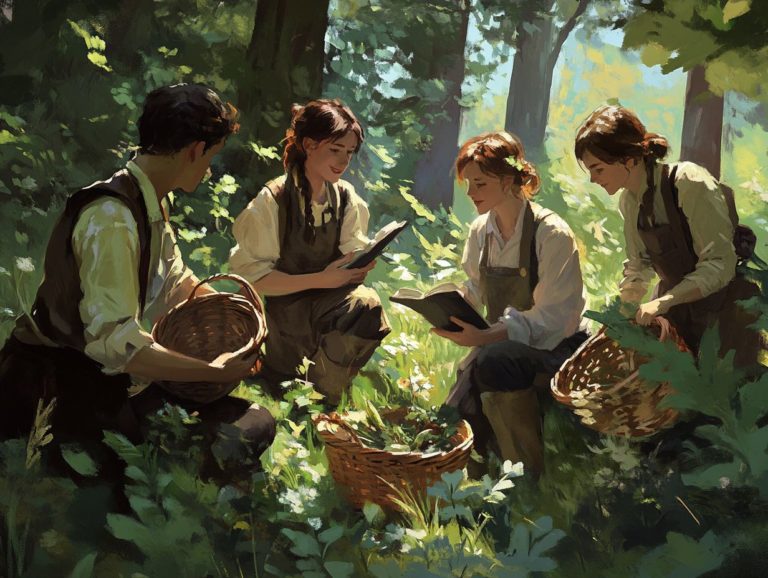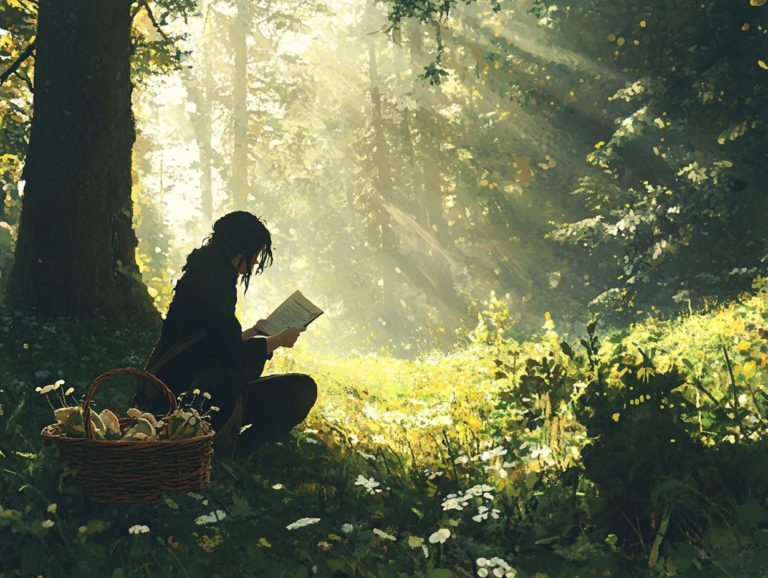How to Capture the Essence of Foraging
Foraging transcends the simple act of gathering wild edibles. It s an immersive journey into nature s pantry, where adventure, sustainability, and personal well-being intertwine.
This exploration delves into the many benefits of foraging, emphasizing its positive effects on both physical and mental health. You ll discover the essential tools and skills required to embark on your foraging journey with confidence, including plant identification techniques and sustainable foraging practices.
Safety is paramount, so you ll learn crucial precautions, how to distinguish between edible and non-food items, adhere to safety guidelines, and ethical practices that foster a sustainable relationship with the natural world.
Ready to discover the secrets of foraging? Join us as we explore the exciting world of wild food!
Contents
- Key Takeaways:
- The Benefits of Foraging
- How to Get Started with Foraging
- Foraging Safety
- Foraging for Food
- Foraging for Non-Food Items
- Foraging Ethics and Sustainability
- Frequently Asked Questions
- What is foraging and why is it important to capture its essence?
- How can I capture the essence of foraging in my food photography?
- What are some tips for capturing the essence of foraging in my cooking?
- What are some common mistakes to avoid when trying to capture the essence of foraging?
- How Can I Include Foraging in My Outdoor Adventures?
- Discover the Joy of Foraging Beyond Food!
Key Takeaways:
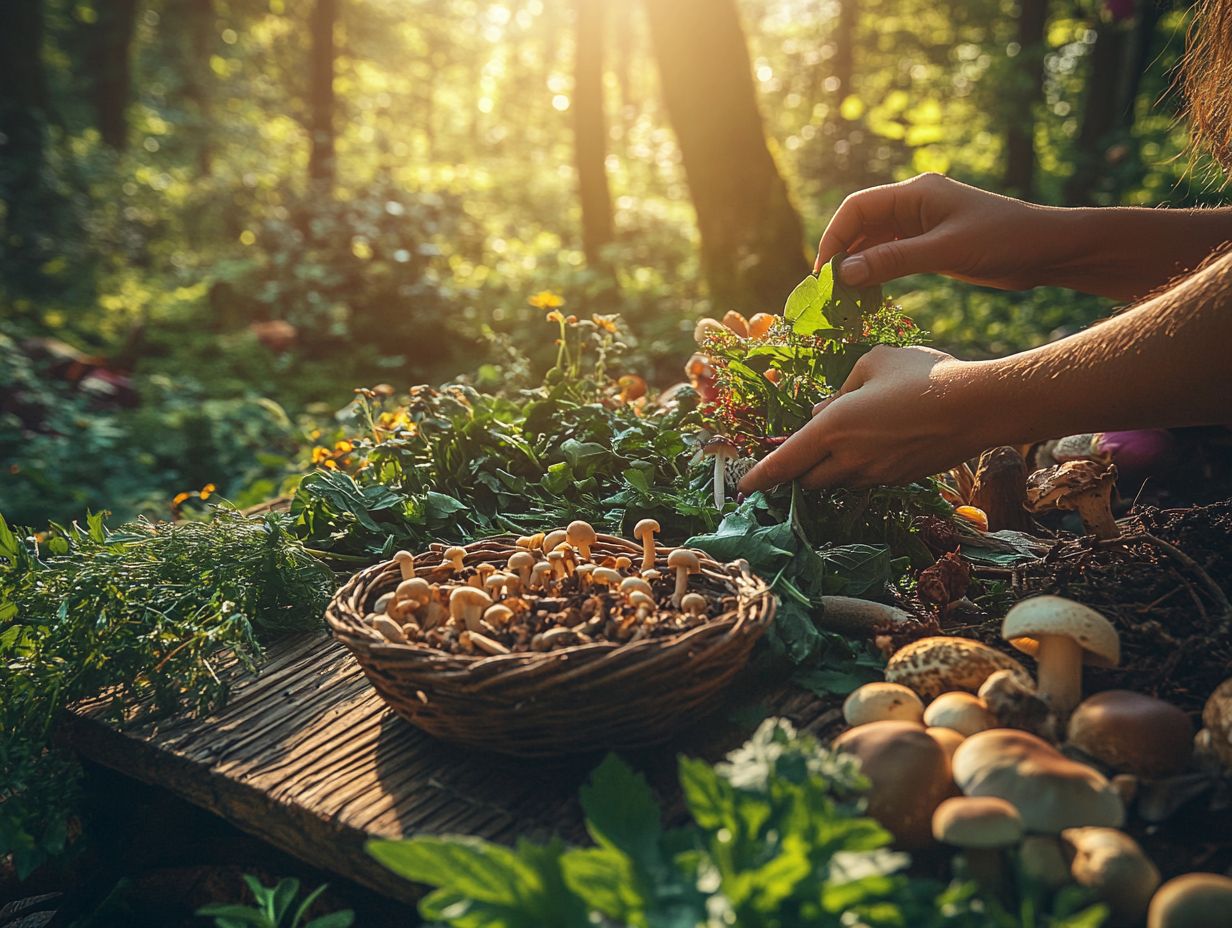
- Foraging offers both physical and mental benefits, such as exercise and stress relief, enhancing community engagement through shared experiences.
- Proper tools and skills are essential for safe and successful foraging.
- Foraging requires knowledge of edible plants and fungi, such as wild mushrooms and nutrient-rich plants, as well as ethical and sustainable practices that honor the environment.
What is Foraging?
Foraging is the art of seeking out and gathering wild plants, mushrooms, and other natural treasures from your environment. This practice includes everything from edible delights like dandelion, burdock, and wild spinach to medicinal herbs such as stinging nettles, wild rose, and other local herbs. Learning how to use foraging techniques in cooking can enhance your culinary skills and appreciation for nature.
Engaging in foraging connects you to your local ecosystems and fosters a deeper understanding of the intricate relationship between plants and people. It offers nourishment while also opening a doorway to appreciate the vibrant flora that surrounds you, especially when you learn how to integrate foraging techniques into your life.
This practice connects us to our past. Communities relied on foraging for food long before farming began.
Today, the revival of wild food movements reflects a growing interest in sustainable practices and self-sufficiency. You might find yourself scouting for chanterelles hidden in lush undergrowth or identifying common edible weeds in urban gardens.
Such foraging not only cultivates respect for nature but also promotes biodiversity, ecological awareness, and environmental consciousness, reminding you of the abundant resources waiting just outside your doorstep.
The Benefits of Foraging
Foraging presents a wealth of benefits that reach far beyond the mere act of gathering food. It promotes your physical well-being by granting you access to nutrient-rich plants and local flora.
It enhances your mental health through a deep connection with nature and nurtures community engagement through shared foraging experiences.
You also embrace food sovereignty by learning about foraging ethics and cultivating environmental care.
Physical and Mental Benefits
Foraging boosts your physical health by encouraging outdoor activity and exercise.
It also significantly enhances your mental well-being. Exploring nature can reduce stress, improve your mood, and foster a deeper connection to the natural world.
This multifaceted activity often involves walking or hiking through diverse terrains. It activates various muscle groups, promotes cardiovascular health, and lets you appreciate the wild flora around you.
As you meander through forests or fields, your body reaps the benefits of increased endurance and flexibility, all while enjoying the intricate plant relationships around you.
Numerous studies indicate that spending time outdoors can elevate serotonin levels, leading to improved emotional stability. Research from the University of Exeter reveals that individuals immersed in natural environments report lower levels of anxiety and a noticeably enhanced overall mood.
Avid foragers often share testimonials reflecting a profound sense of peace and joy derived from their experiences in nature. This blend of physical and mental engagement offers a holistic approach to well-being, and those looking to enhance their skills can explore how to innovate your foraging techniques, which also strengthens the connection to the foraging community.
How to Get Started with Foraging
Embarking on your foraging journey requires a solid grasp of essential tools and skills. You’ll want to familiarize yourself with plant identification techniques, gain insight into local flora, and learn how to spread awareness on foraging techniques while developing an understanding of gathering plants without harming the environment.
This foundational knowledge is vital for anyone eager to explore the rich and diverse world of foraging safely and responsibly.
Key Tools and Skills
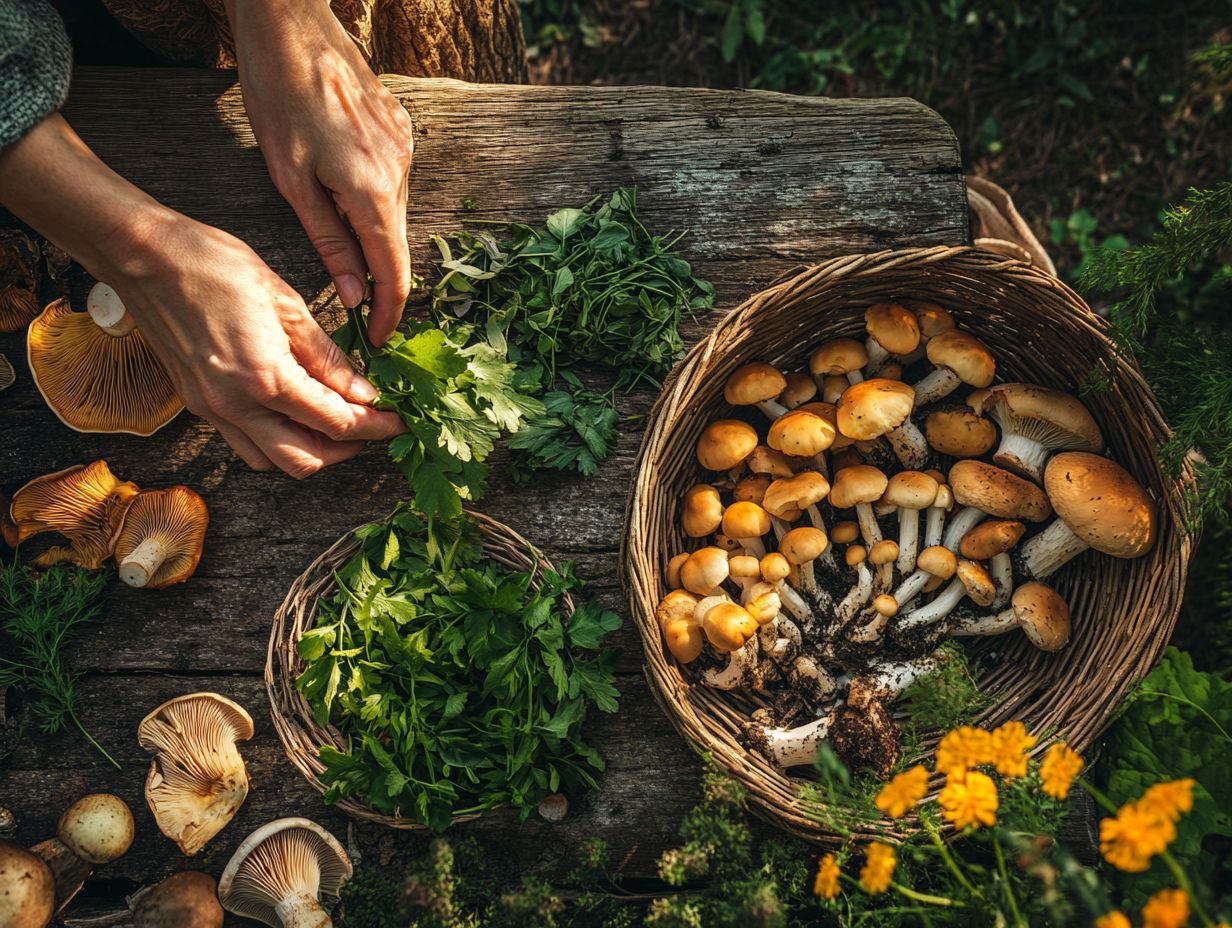
- Reliable guidebook for plant identification
- Sturdy basket for gathering
- Well-stocked first aid kit for safety
Essential tools for foraging include a reliable guidebook for plant identification, a sturdy basket for gathering your finds, and a well-stocked first aid kit to handle any minor mishaps.
These tools create a safer foraging experience and elevate the joy of connecting with nature. A quality guidebook becomes your essential companion, offering detailed illustrations and descriptions to help you confidently identify edible plants while steering clear of toxic varieties.
A sturdy basket is key for collecting your treasures while keeping them fresh, making it easy to transport everything back home.
Having a first aid kit on hand is vital; it prepares you for unexpected encounters, whether it s a nettle sting or a minor scrape, ensuring you stay safe while foraging.
Developing proficiency in identifying plants takes patience and practice. You learn to discern the subtle differences between similar species. Understanding local ecosystems enhances your foraging skills, promotes sustainable harvesting practices, and fosters a deeper respect for the environment.
Foraging Safety
Foraging safety is of utmost importance. You need to understand the potential risks involved in gathering wild plants and fungi.
Follow established safety guidelines to enjoy a rewarding and safe experience outdoors!
Risks and Precautions to Consider
Foraging is a thrilling adventure that connects you to nature’s bounty! However, it s essential to acknowledge the potential risks involved, such as encountering poisonous plants or mushrooms. This reality highlights the importance of adopting proper precautions and safe foraging practices.
These risks are serious and can lead to health issues. Therefore, following safety guidelines and understanding the environmental impact of your foraging practices is crucial. If you’re interested in gathering wild edibles, educating yourself on plant identification which means knowing how to recognize different edible plants is vital. Confusing a delightful chanterelle with a toxic look-alike could have severe consequences.
Other environmental hazards like sharp thorns, pesky insects, and even dangerous wildlife can threaten your outdoor adventures. To minimize these risks, always carry a reliable field guide, dress appropriately for the environment, and ideally, forage with someone who has experience. This strategy enhances your safety and enriches your knowledge throughout your foraging journey.
Foraging for Food
Foraging for food invites you to explore the art of identifying and gathering edible plants and mushrooms. This practice not only enriches your diet with delightful wild food options but also introduces unique flavors to your culinary creations. To fully appreciate this journey, consider learning how to document your foraging journey, often enhanced by cooking with herbs and local ingredients.
It also helps you master various food preservation techniques, allowing you to savor nature’s bounty long after the harvest.
Identifying Edible Plants and Fungi
Identifying edible plants and fungi is an essential skill for you as a forager. This knowledge ensures that you can safely enjoy the delights of wild food and use the medicinal herbs you may encounter. A keen understanding of the unique characteristics of various plants, like violets, is vital.
To effectively spot these natural treasures, you need to sharpen your senses. Pay close attention to both visual and olfactory cues, recognizing key features such as leaf shape, color, and aroma. These often guide you to local herbs and other treasures. For instance, the unmistakable sweet scent of ripe blackberries can guide you to their location, while the distinctive texture of a mushroom’s cap can reveal whether it s safe to eat.
Before indulging in wild edibles, thorough research is vital. Consulting field guides or seeking advice from seasoned foragers can significantly minimize the risk of misidentification. Sharing personal anecdotes can deepen your understanding; stories from respected herbalists like Juliet Blankespoor or John Kallas often illuminate unique ways to recognize and prepare wild edibles, enriching your entire foraging journey.
Foraging for Non-Food Items
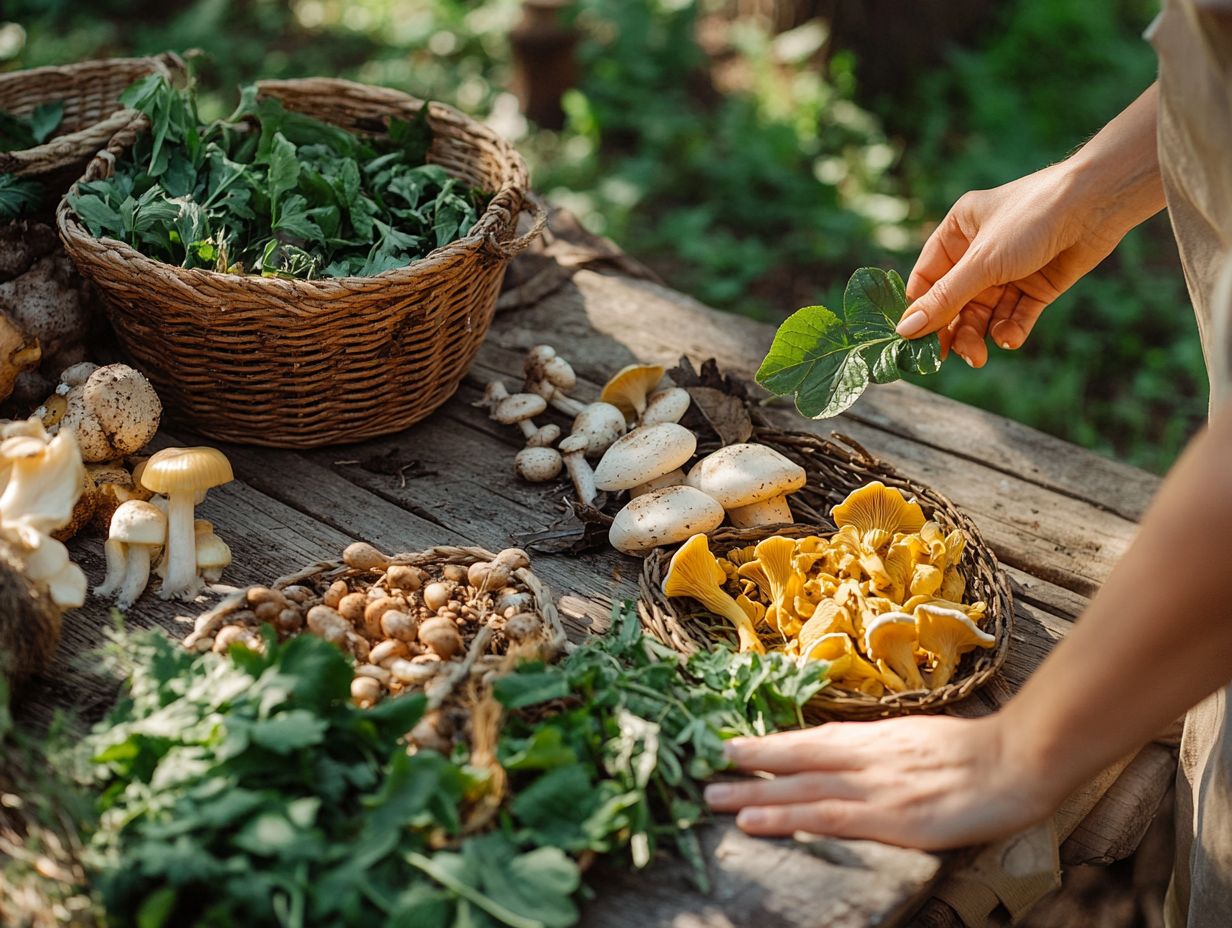
Foraging extends far beyond just food; it includes gathering non-food items such as medicinal herbs and crafting materials. Engaging in this practice can deepen your connection to the natural world and provide valuable resources that enhance your health and inspire your creativity. To learn more, consider mastering the art of ethical foraging.
Crafting and Medicinal Uses
Foraged wild plants offer a fantastic chance for you to dive into various crafting projects and medicinal applications. You can create unique products and herbal remedies that utilize nature’s healing properties, focusing on herbal medicine and teachings from herbalism courses.
Imagine crafting fragrant sachets filled with dried lavender or brewing soothing teas with chamomile. The possibilities are truly limitless! These practices have a rich cultural history, with communities relying on local plants for food, spiritual, and health purposes. For instance, the indigenous peoples of North America traditionally used echinacea to boost immunity and ward off illness.
As you explore foraging today, prioritize ethical sourcing. This commitment protects our environment and honors the traditions of those who came before you. By turning gathered herbs into salves or tinctures, you re not just connecting with your ancestors; you re discovering a sustainable way to integrate nature’s gifts into your everyday life.
Foraging Ethics and Sustainability
Foraging ethics and sustainability are key to responsible gathering practices. They highlight the need for care for the environment, ensuring that the resources you collect remain available for future generations while respecting and preserving local ecosystems.
Responsible Foraging Practices
Responsible foraging practices focus on minimizing your environmental impact while enjoying the benefits of gathering wild foods and plants. Embrace sustainable foraging techniques and understand the value of community sharing in combating invasive species.
Get familiar with local ecosystems by identifying which species are native and which are unwelcome guests. Following guidelines that protect wildlife habitats is crucial. For example, adhering to the principle of “leave no trace” means you take only what you need, leaving plenty for future growth.
Join community initiatives like organized foraging events to connect with fellow enthusiasts and improve your skills in identifying and managing invasive species that threaten local biodiversity. By sharing knowledge and resources, you can play a vital role in maintaining ecological balance, benefiting both nature and your community.
Frequently Asked Questions
What is foraging and why is it important to capture its essence?
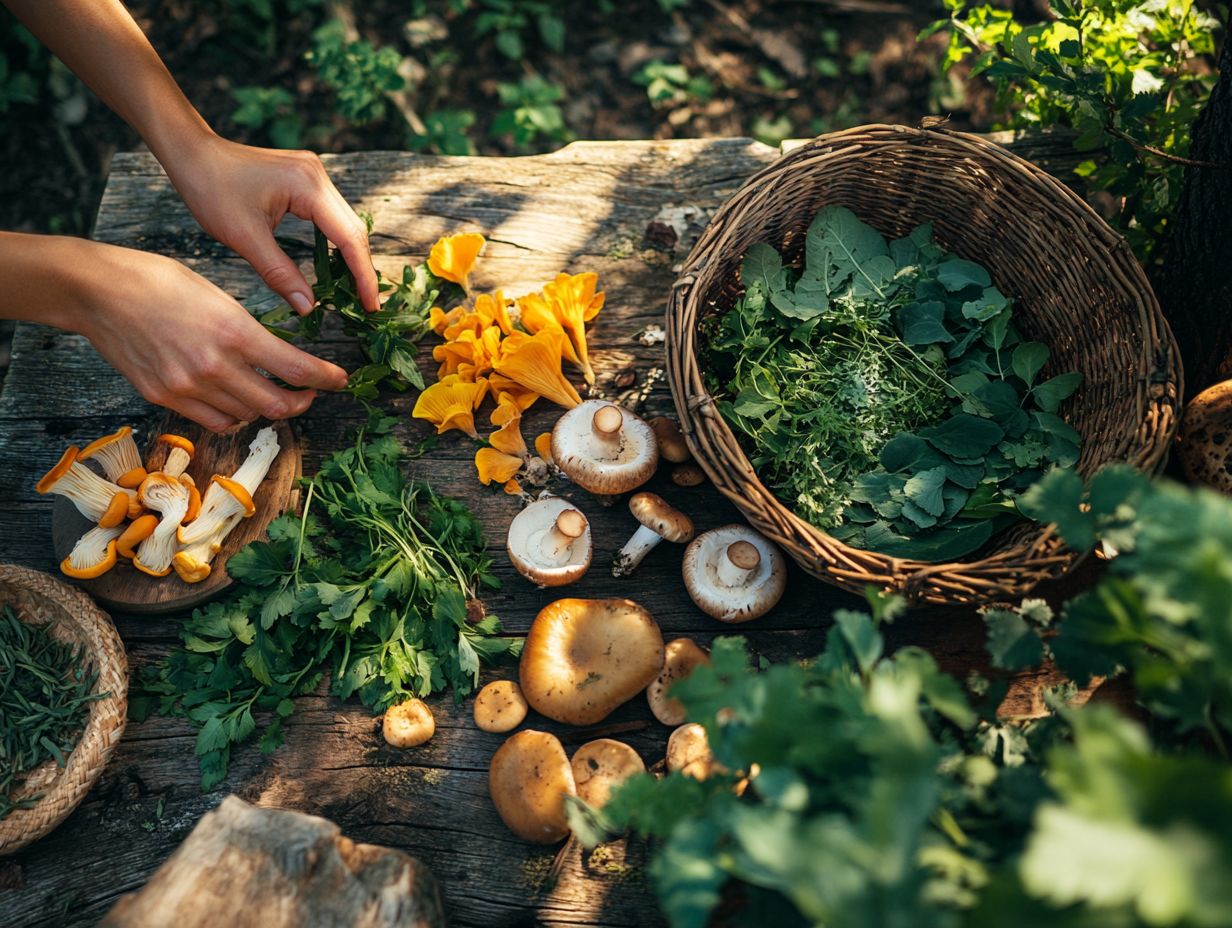
Foraging is the act of searching for and gathering wild food resources. Capturing its essence is vital because it helps us connect with nature, learn about our environment, and appreciate the natural abundance around us. For those interested in enhancing their skills, mastering the art of wild foraging techniques can be incredibly beneficial.
How can I capture the essence of foraging in my food photography?
To capture the essence of foraging in food photography, incorporate natural elements like leaves, twigs, and berries into your composition. Additionally, consider documenting your foraging experiences using natural lighting and earthy tones to enhance the rustic feel of foraging.
What are some tips for capturing the essence of foraging in my cooking?
To capture the essence of foraging in your cooking, use locally sourced and seasonal ingredients. To deepen your understanding, learn how to cultivate a love for foraging locally. Experiment with new and unique flavors, and try to incorporate foraged ingredients into your dishes. Be creative and let the ingredients shine!
What are some common mistakes to avoid when trying to capture the essence of foraging?
- Not properly identifying foraged ingredients. Research and learn about the plants and herbs you collect to ensure they are safe to eat.
- Over-harvesting, which can harm the environment and affect future growth of plants.
Start your foraging adventure today! Learn more about the joy and benefits of foraging to connect with nature and enrich your life.
How Can I Include Foraging in My Outdoor Adventures?
Include foraging in your outdoor activities by going on a walk or hike to find edible plants and herbs. Taste what you discover and enjoy the flavors of nature!
Discover the Joy of Foraging Beyond Food!
You can also use foraging in crafting and art. Create unique pieces with natural materials you gather or use them in fun DIY projects.
Foraging can enhance your mindfulness and meditation, helping you connect deeply with nature and the present moment.
